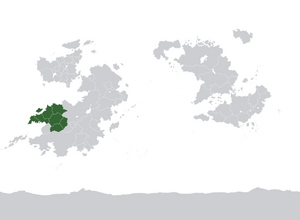Satria
This article is incomplete because it is pending further input from participants, or it is a work-in-progress by one author. Please comment on this article's talk page to share your input, comments and questions. Note: To contribute to this article, you may need to seek help from the author(s) of this page. |
| Satria Satrie | |
|---|---|
 Location of Satria (dark green) | |
| Area | 5,297,582.1 km sq 2,045,407.88 mi sq |
| Population | Roughly |
| Countries and territories | File:Nirala flag.svg Nirala |
| Nominal GDP | $ Billion |
| Time zones | -3 UTC - 0 UTC |
| Capital cities | File:Nirala flag.svg Amit Rahul Sidhu City |
Satria is a socio-culturally-delineated subcontinental region of Coius centred around the Bay of Bashurat, which is conventionally defined in cultural terms as opposed to geography. While the core of Satria has been historically well defined, its peripheries are areas of major cultural intermixing and therefore pose a challenge for classification. The conventional definition of Satria includes the nations of Padaratha, Mahayala, with some definitions also including Baekjeong.
Satria's geography is dominated by flat plains, with a singular mountain range running through eastern Patasura, Rajyaghar, Gulbistan, and west Ajahadya. The Great Steppe, a similarly flexible cultural region, is often superimposed within the borders of Satria and this region has historically been highly important in the development of Satria's culture and ethnic makeup. The subcontinent is dominated by the presence of large rivers,such as the Bashurat River, Dakia River, Basra River, Naratha River, Pakjir River and Upacala River. These rivers have seen the most intensive habitation, as well as intensive agricultural development.
First peopled by homo sapiens roughly 60,000 YBP, Satria saw the flourishing of sedentary agriculture centred on the Bashurat Valley. Several cultural civilisations are attested from this period, with the Uppuria Culture being one of the most well-documented in archaeological records. The Purvan peoples are believed to be the first endemically Satrian civilisational group which formed polities which were able to survive into the ancient era. From around 2000 YBP there is evidence of Boreocoian migration across the Great Steppe, with groups of warrior-aristocracies from modern day Zorasan quickly displacing the extant Purvan polities and pushing them further west. It is at this stage that the Vanavasi, who are often considered the indigenous peoples of Satria, notably diverged from their urban neighbours. While these new aristocrats would initially remain culturally linked to the Bhagic cultural sphere, interbreeding with the Purvan natives was common among the lower classes. The Sattara Basin was the centre of this process, owing to its large populations of both Boreocoians and Purvans, and its comparitive isolation from the homeland of the Boreocoians, and it was here that the ideas which would go on to constitute Jati first emerged. Often simply viewed as a caste system after its exoteric manifestation, Jati is a philosophic worldview which revolves around the ideas of cyclic reincarnation and karma, viewing all life as a way to ascend Mount Sumeru and gain proximity to the divine essence. Jati's emergence would eventually diversify into a multitude of philosophical and religious traditions, leading to the Mahakusumita which is both seen as a period of sectarian violence and of philosophical and cultural importance. This period was ended by the rise of the first Arudharaja (Ascended Ruler), Lakshmana I, whose conquests and policies of religious inclusion brought a degree of stability to the region. The Arudharaja, which is likely related to the Shangean concept of the Mandate of Heaven, would continue to be the core aspect of Satrian politics despite numerous interregna and disputes over its role up until the Togoti invasion which effectively saw the rise of a non-Jatic emperor over most of Satria.
After the fall of the Togoti khaganate, no state would achieve such prestige and much of the region was conquered by Euclean nations throughout the 19th century. This period of colonial rule was marked by the introduction of Sotirianity and general suppression of many local practices, as well as the introduction of new infrastructural developments. The administration of Satria involved far less direct settlement than other areas under colonial occupation, leading to the development of a local administrative class which consisted of many educated Satrians who began to question colonial rule politically. A key warzone during the Great War, the weakening of Euclean control led to the strengthening of independence movements, and the carnage of the Solarian War permitted many such movements to gain significant success. By the end of the 1940s, most of Satria was independent. The following decades were shaped by the Satrian Wars, which pitted the Pan-Satrian Union of Satrian Federal Republics against the fledgling states which had emerged and which eventually wound down to a grudging stalemate. While Ajahadya still claims all of Satria as its territory, this claim is widely ignored on the international scene. Satria is now a key area of rivalry between the Rongzhuo-Zahedan Axis and Senria, with both nations exerting significant political and economic influence over various blocs in the region. Satrian nations tend to be developing, yet better off than other areas of Coius such as Bahia, and are often considered "Southern Democracies" with strong presidencies and other weaknesses to otherwise democratic systems.
Etymology
The name Satria is believed to have been derived from the Solarian Satria, referring to the regions to the south of the Heavenly Dominions. In turn this was derived from Classical Piraean Satria and Ancient Piraean Satyros, which is believed to derive from either Satyros, a mythical explorer said to have been the first to sail to modern day Satria from modern day Piraea or Sattara